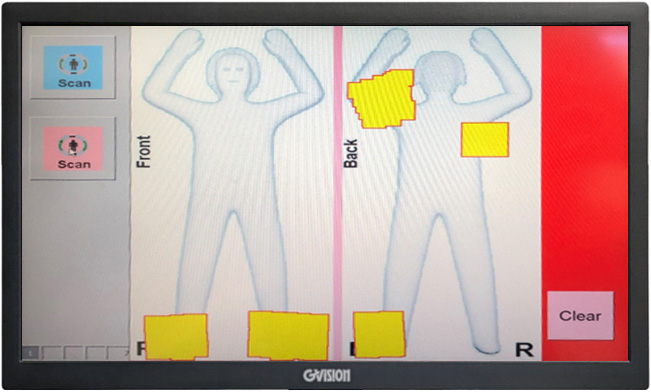AvSec operates Advanced Imaging Technology (body scanner) devices across six New Zealand airports.
We understand that you may have some questions about how body scanners work and what happens at the screening point. We have put together some FAQs below, however, if your concerns are not covered by this information, please talk to a security officer at the screening point.
You may be scanned on any occasion that you are screened, in addition to going through the walk-through metal detector. This can be due to a detection as well as a random selection by the technology.
This is likely just a coincidence. Due to the large number of people scanned, the probability of being selected randomly by the technology every time is low but it is possible.
Body scanners have been introduced at New Zealand airports to detect prohibited items worn or carried on your body, to ensure we are taking the most effective action against emerging threats against civil aviation. They provide an additional, less intrusive method of screening passengers.
Body scanners detect both metallic and non-metallic items. It is essential that you divest every item on your person into an x-ray tray.
All body scanners in New Zealand use non-ionising millimetre-wave technology. This means they do not emit ionising radiation like that of x-rays. The low intensity waves and short duration of the scan means that you are exposed to less energy than other common everyday devices such as mobile phones. The millimetre-waves are reflected off the skin and do not penetrate the body. There are no known health risks from undergoing a scan, so passengers who have a medical condition or are pregnant should not be concerned.
No, you will have to place these objects with your other possessions in the tray for screening separately.
No, only one person at a time can use the AIT body scanner. The waves of the security scanner are reflected off the skin, so stepping into the AIT body scanner with a child together means that no clear image can be created. Children who are under 1.02 metres in height cannot be scanned.
If the body scanner detects an object and indicates its location on the genderless image on the screen, the security officer will conduct a pat-down search of the area indicated.
The security officer sees a genderless figure of the person scanned on a screen next to the AIT body scanner. The image indicates whether a passenger is declared “OK” or if the AIT body scanner detects an object on the body. The location of the object is indicated on the image, and the security officer will conduct a pat-down search of the area(s) indicated.

Yes, you can see this image as you exit the scanner. The genderless figure will have marks showing any object(s) that the scanner has detected.
No, the scanner makes an analysis based on raw scan data. The scan data is not saved, and no images are saved and cannot be retrieved later.
Body scanners used in New Zealand are equipped with special enhancements to protect your privacy. Images are displayed as a genderless figure to highlight areas that require further investigation. The body scanners cannot store any personal information or identifying information about passengers.
Yes, security officers that operate the AIT body scanner have been trained in the use of the equipment being used and the pat-down search techniques to clear any object identified during a scan.
For the proper operation of the equipment, the passenger must be able to stand for several seconds with raised hands. This will not always be possible for someone on crutches or in a wheelchair. These passengers will be screened by means of a pat-down search and investigation of the aids. As the equipment is intended to provide an alert in the event objects are carried on the body, it is possible that prosthetic limbs will also trigger the alert. These alerts will also be resolved by a pat-down search by an officer of the same gender.
Active implantable medical devices, including pacemakers and defibrillators are designed to meet the series of standards relating to electrical safety and protection by the International Electrotechnical Commission. One part of that standard requires medical devices to be protected from interference from external energy sources, such as mobile phones and other electronic equipment. The power levels (and peak electrical field levels) are significantly lower than what a person might experience from the use of other everyday electronic equipment, such as mobile phones. Due to the location of the medical devices (under the skin) and the electromagnetic compatibility of these devices, there are no known safety concerns in relation to people with these devices undergoing a body scan.
If you have any questions about this topic, use our contact form, or email reception@avsec.govt.nz.